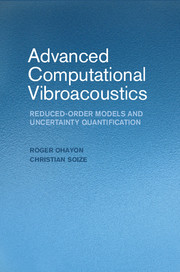Book contents
- Frontmatter
- Contents
- 1 Principal Objectives and a Strategy for Modeling Vibroacoustic Systems
- 2 Definition of the Vibroacoustic System
- 3 External Inviscid Acoustic Fluid Equations
- 4 Internal Dissipative Acoustic Fluid Equations
- 5 Structure Equations
- 6 Vibroacoustic Boundary Value Problem
- 7 Computational Vibroacoustic Model
- 8 Reduced-Order Computational Model
- 9 Uncertainty Quantification in Computational Vibroacoustics
- 10 Symmetric BEM without Spurious Frequencies for the External Acoustic Fluid
- References
- Glossary
- Author Index
- Subject Index
8 - Reduced-Order Computational Model
Published online by Cambridge University Press: 05 August 2014
- Frontmatter
- Contents
- 1 Principal Objectives and a Strategy for Modeling Vibroacoustic Systems
- 2 Definition of the Vibroacoustic System
- 3 External Inviscid Acoustic Fluid Equations
- 4 Internal Dissipative Acoustic Fluid Equations
- 5 Structure Equations
- 6 Vibroacoustic Boundary Value Problem
- 7 Computational Vibroacoustic Model
- 8 Reduced-Order Computational Model
- 9 Uncertainty Quantification in Computational Vibroacoustics
- 10 Symmetric BEM without Spurious Frequencies for the External Acoustic Fluid
- References
- Glossary
- Author Index
- Subject Index
Summary
As explained at the end of Chapter 7, the computational vibroacoustic equation could be solved directly ω by ω, but, as explained in Chapter 1, it is recommended to use a reduced-order computational model, which is constructed as follows. The strategy used for constructing the reduced-order computational model consists in using the projection basis constituted of:
• The acoustic modes of the acoustic cavity with fixed boundary and without wall acoustic impedance. Two cases are considered. The first one is a closed acoustic cavity (the internal pressure varies with variation of the volume of the cavity), for which the boundary value problem has been defined in Section 6.2. For an almost closed cavity with a nonsealed wall, which are often encountered (the internal pressure does not vary with a variation of the volume of the cavity), an adapted procedure, derived from the closed cavity case, will be presented. The second one concerns an internal cavity filled with an acoustic liquid with a free surface for which the boundary value problem has been defined in Section 6.3.
• The elastic structural modes of the structure, taking into account a quasi-static effect of the internal acoustic fluid on the structure. The constitutive equation of the structure corresponds to an elastic material (see Eq. (5.35)) and consequently, the stiffness matrix of the structure has to be taken for ω = 0.
Information
- Type
- Chapter
- Information
- Advanced Computational VibroacousticsReduced-Order Models and Uncertainty Quantification, pp. 54 - 66Publisher: Cambridge University PressPrint publication year: 2014
